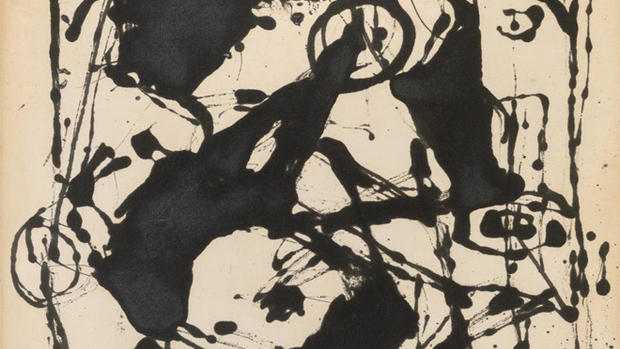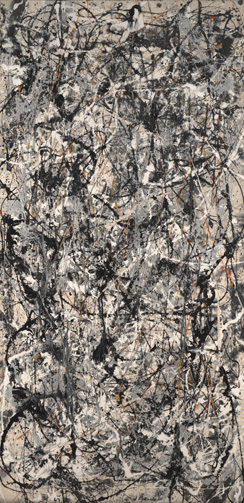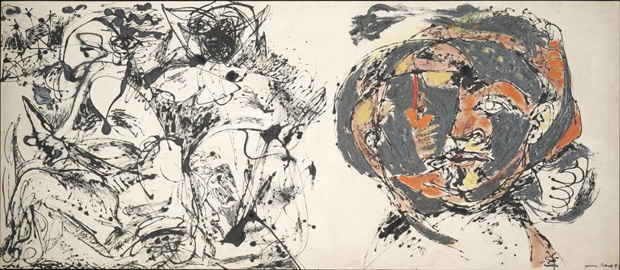Jackson Pollock's black period
Few modern artists have been more acclaimed than Jackson Pollock, who died sixty years ago this coming August. One period of his career has tended to be overlooked ... an omission Rita Braver is about to correct:
Jackson Pollock's complex and colorful, multi-layered canvases took the international art world by storm beginning in the late 1940s.
"There was painting before Jackson Pollock, and there's painting after Jackson Pollock," said Gavin Delahunty, the curator of a new Pollock exhibit at the Dallas Museum of Art. It features more than 70 works by the artist, including some of his best-known paintings, such as "Cathedral" (1947).
But the exhibit focuses mostly on a series done in 1951, when Pollock painted only in black.
"On some levels you might say it kind of looks like a doodle," said Braver.
"It's doodle-y," said Delahunty, "because he's still thinking it through, 'Can I make paintings exclusively using black on raw cotton substrate that can maintain the tightness and excitement of my classic paintings?' And this is the moment that the penny drops."
But the events surrounding that moment comprise a tale of triumph and tragedy.
Paul Jackson Pollock was born in 1912 in Cody, Wyoming, one of five sons. The family bounced around the Southwest trying to eke out a living. Still, Pollock's mother encouraged his early interest in art.
"When he was in high school, he took art classes, and those were the only classes he really seemed to be very good at," said Helen Harrison, who runs the Pollock-Krasner Home & Study Center near East Hampton, Long Island. She says that at age 18, Pollock traveled to New York City to study with American muralist Thomas Hart Benton, whose influence can be seen in Pollock's early work.
Gradually, however, Pollock became fascinated with abstraction, his work drawing the attention of influential collectors and gallery owners. But as dramatized in the 2000 biopic "Pollock," starring Ed Harris, he had a serious drinking problem.
And so in 1946, his wife, Lee Krasner (herself an accomplished painter) convinced him to move from New York City to East Hampton.
"I think there was definitely an incentive to get him away from the drinking buddies," said Harrison. "But also just to give him the space, and the kind of mental space, that he needed to really develop himself. And he did."
It was here that Pollock developed the style that really made him famous -- dripping and pouring paint directly onto canvas.
"I usually paint on the floor," he explained in a 1951 film interview. "I enjoy working on a large canvas. Having a canvas on the floor, I feel nearer, more a part of the painting."
And though the work was puzzling to some, by 1949 Life Magazine was asking if Pollock was America's greatest living painter.
"As a matter of fact, most people who wrote their letters to the editor -- over 500 of them in response -- said, 'No!'" said Harrison. "But those who did like it were crazy about it."
Some did call him "Jack the Dripper," and the floor of his studio is still splattered with his colorful industrial paint, plus a few footprints.
But just as sales of Pollock's layered abstractions were taking off, he started to work in black, with recognizable images peeking through: a head, an ear, arms.
"It is part of the transition of the black paintings that Pollock starts to resuscitate, or bring back to life, some of the figuration that had previously dominated in his painting," said Delahunty.
"Did anybody rush out to buy them?" Braver asked.
"No, sadly not. I think people were confused; 'Why would someone who has just developed a new language of painting go off on a tangent?' But it was Pollock distilling and purifying everything he had learned."
Jackson Pollock would return to color, but by the mid-1950s he was drinking again, and cheating on his wife. In 1956 he crashed his car while driving drunk. His mistress, also in the car, survived; Pollock and a second passenger did not. He was just 44.
The man who at most made a few thousand dollars for a painting never lived to see his works go for millions -- or to fulfill his artistic promise:
Had Jackson lived, said Delahunty, "I think we would have seen some of the great bodies and periods of work that you get with Matisse and Picasso, singular periods that they did in mid-career, late-career. And it just fills me with pain to know that we never got to see that from Jackson Pollock."
To view an ad for "Jackson Pollock: Blind Spots," click on the player below.
For more info:
- "Jackson Pollock: Blind Spots" at the Dallas Museum of Art (through March 20)
- Pollock-Krasner Home & Study Center, East Hampton, N.Y.
- "Pollock," directed by Ed Harris, available on DVD, and on Digital Video via Amazon, Google Play, iTunes and Vudu
For fun:
Go to jacksonpollock.org, with a mouse. Just do it.




